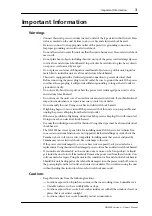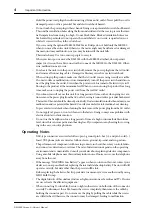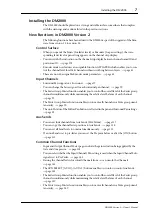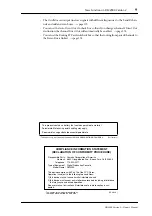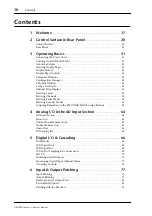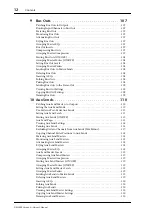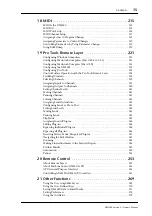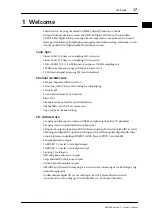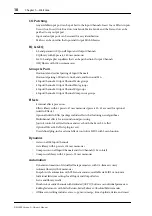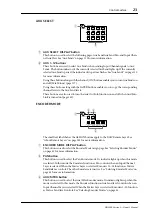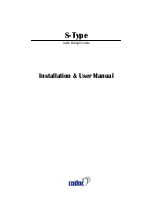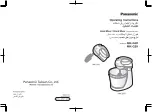
8
Important Information
DM2000 Version 2—Owner’s Manual
Monitor
•
The level of the Surround Monitor can be reset to 85dB SPL.
→
•
A new parameter has been added to Bass Management on the Surround Monitor Setup
page.
→
•
Surround Monitor is also available when Surround mode is set to Stereo.
•
You can simultaneously select BUS and ASSIGN1 or BUS and ASSIGN 2 for surround
monitoring.
•
You can select from Slot Channel 9 through Channel 16 as Surround Monitor signal sources.
•
You can simultaneously select 2TRD, D2, D3, A1, or A2, and STEREO, ASSIGN1, or
ASSIGN2 as Control Monitor signal sources.
•
You can select the Talkback mic signal as the Studio Monitor source.
→
Effects, Plug-ins and GEQ
•
You can add optional Add-On Effects to the preset effects.
→
•
The channel faders enable you to adjust the gain for each band in the graphic EQ.
→
Scene Memory
•
You can globally apply the Fade Time setting to all scenes.
→
•
You can globally apply the Recall Safe setting to all scenes.
→
•
Any channel or parameter settings in the current scene can be copied and pasted into other
scenes.
→
•
You can select more parameters for the Recall Safe function.
→
Automix
•
You can insert the current mix parameters in a region specified in the Automix data.
→
•
Touching the faders can punch parameter values in and out if the corresponding OVER-
WRITE button is set to on.
→
•
Some parameters related to timecode synchronization have been added.
→
Remote Control
•
The Joystick or the controls in the SELECTED CHANNEL section enable you to control Pro
Tools Surround Pan settings.
•
The USER DEFINED KEYS enable you to switch windows in the included Studio Manager
application software.
•
You can remotely control the Yamaha AD8HR A/D Converter.
Other Functions
•
A user-assignable layer enables you to assign Channels to Remote layer targets.
→
•
You can also select General DAW (for DAW software that supports the Pro Tools protocol)
or Cubase SX as the target for a Remote layer.
→
•
Yamaha’s proprietary Advanced DAW protocol has been added to Nuendo, Cubase SX, and
General DAW. This enables you to control these devices using the DM2000’s SELECTED
CHANNEL section. (Controllable functions vary depending on the DAW software and ver-
sion you are using.)
•
You can now assign any of 214 functions to the USER DEFINED KEYS.
→
•
You can assign the selected channels to a Fader or Mute group using the USER DEFINED
KEYS.
→
•
An Operation Lock function prevents unintentional edits and uses a password to restrict
access to panel operation.
→



